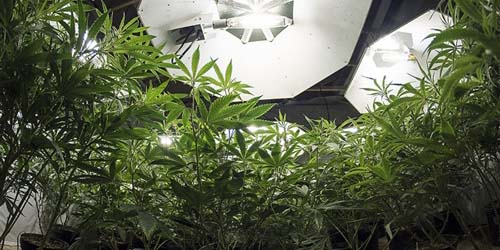
During the life of your weed plant, light is the most important factor. Sunlight or the use of a grow light determine how big your weed gets and ultimately also the yield. When you imitate the sun and grow weed indoors, you need to choose a grow light. There are a number of things to consider. In this article we tell you all about light output and the effects it has on growing.
In this article:
- Growing schedule to grow weed indoors
- HPS lamp or LED Grow lamp
- Spectrum
- Measuring light intensity
- PAR vs. Lux vs. Lumen
- More Light = More weed
- Conclusion
Growing schedule to grow weed indoors
In the guide to growing weed you can read that an 18/6 schedule is usual for the growth phase of the weed plant. Later on it says that a 12/12 schedule is needed for your weed to flower. Don't worry: in theory this is correct. Many growers agree that these two schedules provide a good balance between respectable yields and a not-too-high energy bill.
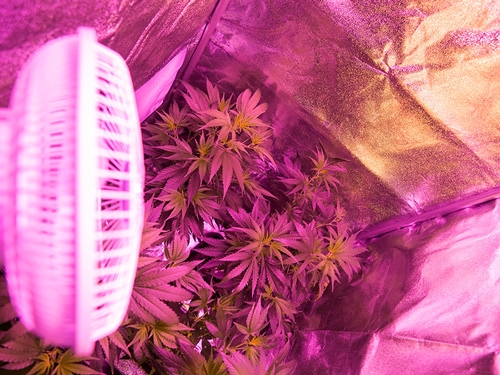
Want to experiment with alternative lighting or growing schedules? Check out this article on the pros and cons of extending or drastically shortening the "fake day" when growing weed indoors!
HPS lamp or LED grow lamp
The decision to opt for an HPS lamp or LED grow lamp does not only have to do with lowering the energy bill. The two lamps use totally different techniques to get that much-needed light onto the leaves of your weed plant. First of all: HPS is the name of the bulb you screw into the lamp. This kind of lamp is actually called a HID (High Intensity Discharge) lamp. It is fitted with a device to switch it on and prevent your fuses from blowing. Thanks to its warm, yellow light, the HPS (High Pressure Sodium) is ideal for the flowering period of weed plants. Although you can also use them for the growing period, a cooler coloured grow light is more suitable. An MH (Metal Halide) lamp contains a different type of gas and the ignition technique is slightly different to that of HPS.
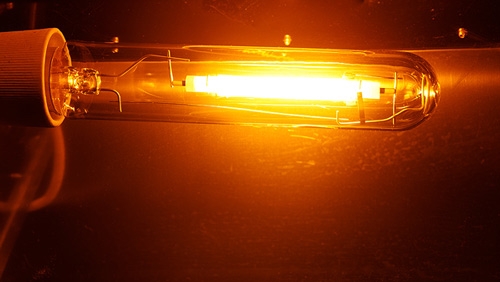
The fact that an HPS is also suitable for the growth phase has to do with the fact that this type of lamp produces a broad spectrum of light. That is scientific language for "several colours at the same time". With LED growing it is a different story. One LED only emits a very small part of the visible light. This has a number of advantages. The energy required is much lower for the same light output and the heat production can be lower as a result.
Spectrum
Our skin turns brown or red when we walk in the sun. This is due to an invisible "colour" of light in sunlight that we call UV radiation. Yet we do not turn brown when a blue light hits our skin. And yet blue and UV are not that far apart. Weed plants are similarly sensitive to certain colours of light but not to others. Therefore, it is pointless to run a green lamp at high power, so to speak, in the hope that they will grow faster.
(Weed) plants grow and flourish thanks to the process of photosynthesis. Carbon dioxide and water are converted by light into oxygen and sugars with which a plant grows. But photosynthesis, like the tanning of our skin, does not work if the colour of the light is not right. You can set the lamp as bright as you like, but if the leaf is not sensitive to that light, nothing will happen. Well, dehydration and burning will become a problem in the long run. To prevent this and to prevent senseless power consumption, it is so important, especially with LED lamps, that the correct colour LEDs are used.
Measuring light intensity
The amount of light can be measured. The intensity of the lamp is measured in Lumen (lm). This value is sometimes found on the packaging of glow bulbs, LED bulbs and low-energy light bulbs so that you can easily compare them with each other. The power or wattage is very different for these three types of lamps.
When growing weed indoors the distance from the lamp is also important. Because the intensity of the light from a lamp decreases with distance. This is why we look at the amount of lux. With a lux meter, you can easily measure how light it is somewhere. It is a bit of an abstract concept. So let's look at some practical measurements.
- 0.3 Lux - Full moon at clear sky
- 50 Lux - Ambient light in living room
- 80 Lux - Bright light in kitchen or living room
- 320 - 500 Lux - Office lighting
- 400 Lux - Sunrise or sunset on a clear day
- 1000 Lux - Cloudy day / Studio lighting
- 10,000 - 25,000 Lux - Clear day, but not full sun
- 32,000 - 100,000 Lux - Direct Sunlight
Now let's compare that with how much light weed plants need:
- Cloning and seedlings - 5,000 - 7,000 lux
- Weed plant in the growth phase - 15,000 - 50,000 lux
- Weed plant in the flowering phase - 45,000 – 65,000 lux
It is recommended that weed plants be given no more than 75,000 lux. This is because weed plants reach a maximum growth rate around this level. It could be done, but then the plant would need to be provided with a supply of extra carbon dioxide (CO2), and the extra results would be minimal. The extra gain does not outweigh the higher costs [1].
PAR vs. Lux vs. Lumen
Lumen is the amount of light that a lamp can emit. Lux is the amount of light on a certain surface at a certain distance. With PAR we go a step further.
For the LED grow light we have learned that the type of LEDs makes a big difference to the performance of the light. Therefore, a grow light bulb is equipped with another way of determining the light intensity.
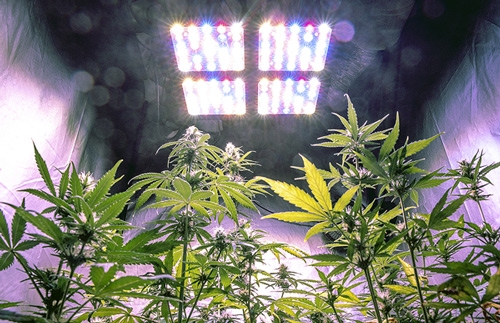
The PAR (Photosynthetically Active Radiation) is the light that actually contributes to the growth and flowering of your plants. Light that is "visible" to your plants is also expressed in the unit PPFD or µmol/m2/sec. Without going into too much detail about these things, we can tell you from the research cited above what value you should use for indoor weed growing:
- Optimal PAR / PPFD value in the growth phase: 300 - 400 µmol/m2/sec
- Optimal PAR / PPFD value for the flowering phase: 600 - 1500 µmol/m2/sec
The PAR value also depends on the distance of the lamp from the plant. When growing with LED light, however, the ideal distance also depends on the type of LEDS, the distance between them and the power. Usually this kind of information and the desired distance from the grow light are listed with the better LED grow lights. And if you buy a real grow light you don't have to worry about the type of LEDs and their colour.
How many lumens for HPS grow lights?
With HPS and MH grow lights, it is a little easier. Do you have a growing space that is larger than one square metre? Then choose a lamp or lamps with a total light output of more than 20,000 lumens. Use this rule of thumb to determine the height of your grow light: 10% of the wattage of the lamp in centimeters. So if you use three 400 Watt lamps, hang all three at 40 centimetres above your plants.
PAR and Lux conversion
There are very expensive PAR meters for sale at online specialist shops. But if you use a much cheaper lux meter, you can also convert the two. The condition for converting PAR and lux is that you use the same lamp that you can find online. The following conversion table is for example suitable for the Philips SON-T 1000W/400V lamps. We do not recommend any particular lamp, but only share data that we have found elsewhere [2,3]. Growing weed with lamps is not allowed in the Netherlands. We therefore take no responsibility for breaking the law. That responsibility lies with yourself.
|
Lux |
PAR (µmol/m2/sec) |
Watt per square meter (including VSA) |
|
6000 |
68 |
55 |
|
25.000 |
282 |
230 |
|
45.000 |
507 |
414 |
|
65.000 |
733 |
598 |
|
110.000* |
1240* |
1012* |
* More than 75,000 lux is not recommended for weed plants.
More light = More Weed
In a 2018 study by two American companies (where weed growing is legal), weed company OutCo investigated the ideal amount of light together with grow light company Fluence. They too show that weed reaches a kind of saturation point around 1200 µmol/m2/sec light. Therefore it wouldn’t make sense to hang more powerful lamps.
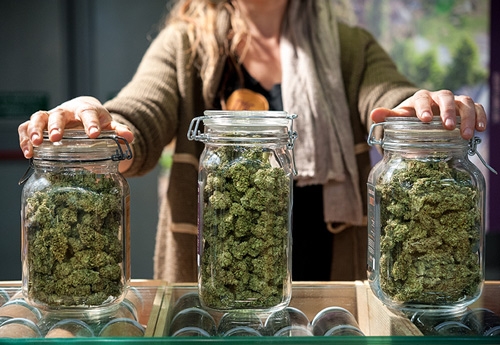
The greatest gain was achieved by increasing the amount of light from 400 to 600 μmol/m2/s. A 51% increase in plant yield was obtained. The type of LED lighting used also gave a higher yield with the same power HPS lamp [4]. Does that automatically mean that LED is better than HPS? You cannot conclude that from this research. You can only say that these particular Fluence SPYDRx PLUS LED lights performed better than the chosen HPS light. Especially in LED grow lights there is a huge difference. Ordering one from Aliexpress is absolutely no guarantee of a higher yield and a lower energy bill.
|
Light installation |
Energy consumption (including VSA) |
THC percentage |
Yield (grams of fresh weed per square metre) |
|
LED 400 µmol/m2/s |
330W |
21.4% |
368 |
|
LED 600 µmol/m2/s |
560W |
21.7% |
556 |
|
HPS 700 µmol/m2/s |
1045W |
19.1% |
615 |
|
LED 800 µmol/m2/s |
660W |
21.4% |
710 |
|
LED 1200 µmol/m2/s |
1000W |
20.8% |
775 |
Results from the research by Fluence and OutCo [4].
Conclusion
The question "how much light does my weed plant need?" turns out to be twofold. Firstly, you can answer the question with how many hours of light a plant needs per day. On the other hand, how strong that light should be. The best light intensity is a complex question if you really look into it. Certainly when you satisfy your insatiable hunger for light with an LED grow light. Do you want to know more about the differences between growing with HPS or LED lamps? Or are you just looking for the best grow light for you? Then read this article where we show you a handy selection guide.
Sources:
- [1] Chandra, S. et al. “Photosynthetic response of Cannabis sativa L. to variations in photosynthetic photon flux densities, temperature and CO2 conditions”. Physiology and Molecular Biology of Plants, Springer Nature. Oct. 2008.
- [2] Dueck, T. “Licht & LEDs in de Kas”. Wageningen University & Research. 24 Jun. 2008.
- [3] “Omrekenen van LUX naar PAR en Globale Straling” Hoogendoorn. 2001.
- [4] Justice, A. “The Experiment: Light Intensity Impact on Yield and Secondary Metabolites” Fluence, OutCo. 2018]